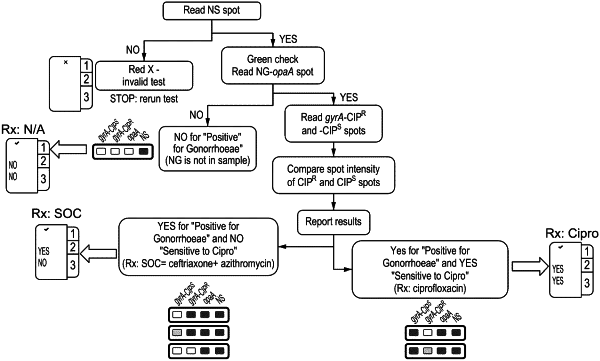| CPC C12Q 1/689 (2013.01) [C12Q 1/04 (2013.01); C12Q 1/18 (2013.01)] | 20 Claims |

|
1. A molecular diagnostic device, comprising:
a sample preparation module containing a primer set and being configured to mix the primer set with a biological sample to produce an input solution, the biological sample suspected of comprising a polynucleotide from a target organism, the primer set targeting a first genetic locus in a polynucleotide associated with the target organism and a second genetic locus in a polynucleotide associated with a single nucleotide polymorphism (SNP) locus in the polynucleotide;
an amplification module including a reaction volume and a heater, the reaction volume configured to receive the input solution, the heater configured to convey thermal energy into the reaction volume to amplify the polynucleotide to produce an output solution containing a first amplicon comprising the first genetic locus and a second amplicon comprising the second genetic locus;
a detection module including a first probe, a second probe, and a third probe, the first probe designed to bind to the first genetic locus, the second probe designed to bind to the second genetic locus if the second genetic locus comprises a first target allele associated with resistance of the target organism to a treatment, the third probe designed to bind to the second genetic locus if the second genetic locus comprises a second target allele associated with susceptibility of the target organism to the treatment; and
a reagent module containing a reagent formulated to facilitate production of a first signal, a second signal, and a third signal, the first signal indicating the presence of the bound first genetic locus, the second signal indicating the presence of the bound second genetic locus that comprises the first target allele, and the third signal indicating the presence of the bound second genetic locus that comprises the second target allele, wherein
the second probe has a second probe melting temperature for hybridization to the second genetic locus comprising the first target allele,
the third probe has a third probe melting temperature for hybridization to the second genetic locus comprising the second target allele, and
the second probe melting temperature is different from the third probe melting temperature.
|